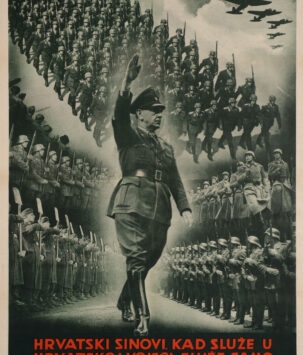Showing 13–24 of 37 results
-
Poster addressing Flemings to join the ranks of the Germanic SS, collectively referring to SS organizations in Belgium, Denmark, the Netherlands and Norway, whose inhabitants were considered pureblooded aryans like the Germans themselves.
-
Poster for a Flemish-German cultural exchange held in Ghent. The famous Gravensteen can be seen forming the backdrop.
-
Poster bearing the fascist paramilitary Hirden’s insignia, the fascist Nasjonal Samling’s paramilitary wing. Calls for Norway’s reconstruction.
-
Poster from the Vlaamsch Nationaal Verbond (Flemish National League, VNV).
-
The Légion des volontaires français (LVF) was a collaborationist unit composed of Frenchmen who fought to defend Europe against Bolshevism. It was later redesignated as the Waffen-SS ‘Charlemagne’ Brigade, named after the legendary medieval Frankish King Charlemagne. The LVF originated as an independent initiative by a coalition of far-right factions in Vichy France who were disillusioned with the liberalism of the Third Republic. The Legion’s flagpole top seen here is a winged helmet of ancient Gaul, and alongside the unit’s later identification with the legend of Charlemagne, we see the clear and distinct influence of romantic historicism and French national mythology. The Waffen-SS ‘Charlemagne’ Brigade distinguished itself in the Battle of Berlin in 1945, where it remained as one of the last defenders around Hitler’s Führerbunker.
-
A poster promoting the collaborationist Légion des volontaires français (LVF). The LVF was a military unit composed of Frenchmen who fought for the German Wehrmacht during the Second World War, ostensibly to defend Europe against Bolshevism. It was later redesignated the Waffen-SS “Charlemagne” Brigade named after the legendary medieval Frankish King Charlemagne. The LVF originated as an independent initiative by a coalition of far-right factions in Vichy France who were disillusioned with the liberalism of the Third Republic.
The Charlemagne Brigade distinguished itself in the Battle of Berlin in 1945, where it remained as one of the last active defenders in the area of Hitler’s Führerbunker complex in a powerful demonstration of chivalric gallantry befitting of their namesake.
-
Poster from occupied Flanders advertising a photo exhibition for the SS. The runic insignia of the SS flank a sword to the backdrop of a Flemish lion.
-
Army recruitment poster from the Independent State of Croatia. The leader Ante Pavelić can be seen at the forefront saluting his fascist legions with an address to the nation.
-
Spanish poster depicting a triumphant Falangist soldier standing atop a bloodied Marxist beast. The Falange Española (Spanish Phalanx) is a fascist political organization founded by José Antonio Primo de Rivera, taking its name from the heavy infantry formations of ancient Greece. It promoted the revival of the Spanish Empire, called for a national syndicalist economy and partook in the Spanish Civil War.
-
Poster issued by the Germanic SS of Norway depicting a soldier of the SS clad in chainmail atop a Viking longship. Typical fascist imagery drawing elements from the past which are incorporated into contemporary narratives about the historical continuity of a modern people’s existence.
-
Finely crafted stained glass dedication of the Flemish nationalist paramilitary leader and Waffen-SS martyr Reimond Tollenaere.
-
The Battle of Stiklestad in 1030 is considered one of the most famous battles from Norwegian history, holding great significance as part of the country’s national myth. A medieval warrior from the battle is likened to his modern day counterpart, a member of Norway’s fascist paramilitary.











